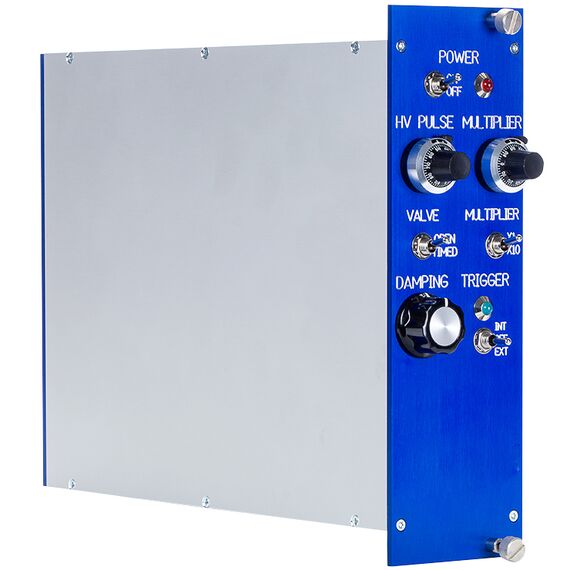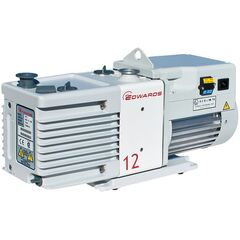Vacuum Pulsar Pulse Valve Driver for 28 V High-Speed Pulsed Solenoid Valves, Analog Controls.
Compare with Parker Iota One Pulse Valve Driver, Parker Part Number: 060-0001-900.
Ideal Vacuum's Pulsar Valve Driver is a benchtop or rack mountable driver for high-speed solenoid valves (28 VDC). Supported models include Parker Series 9 and 99 pulse valves and Ideal Vacuum pulse valves. Pulse duration ranges in microseconds to milliseconds can be selected. External trigger mode can be selected for precise timing control using the back panel BNC jack provided for input TTL trigger signals. A selectable internal 10 Hz trigger mode is provided for initial setup and testing purposes. The Pulsar operates on single phase 115 VAC and can produce repetition rates up to 250 Hertz. A shielded cables is included for connection to the valves.
This Pulsar model has analog controls and display.
The Pulsar is often used to generate pulsed molecular beam sources for laser spectroscopy experiments. Short, timed, supersonic gas pulses can be generated to deliver the sample to a laser pulse when it arrives, dramatically reducing the amount of sample used compared to continuous jet systems.
Advantages of pulsed jet spectroscopy include:
- Reduced sample consumption means lower operating cost and less time spent synthesizing samples and precursor compounds.
- Reduced gas load on vacuum systems means you can use smaller, less expensive pumps to maintain the same vacuum level.
- Reduced gas in the system means less background absorption and higher signal to noise.
- Short, supersonic pulses get very cold as the gas expands, reducing doppler broadening and spectral complexity.
Pulse Driver Waveform Controls:
- Opening High Voltage Pulse - Provides the energy needed to quicky get the solenoid armature moving to open the valve. The width of the high voltage pulse is user adjustable from the front control knob "HV Width"
- Holding Low voltage - Provides energy needed to keep the valve open. The width of the holding voltage is user adjustable from the front control knob "LV Width"
- Dampening Voltage - Provides energy needed to quickly close the valve and minimize bouncing of the solenoid armature. The dampening intensity is user adjustable from the front control knob "Dampening"
Optimizing the pulse valve driver's waveform function delivers maximum gas density producing higher concentration of molecular species in the detection region while keeping the total gas load to a minimum. The Ideal Vacuum Pulsar pulsed valve driver has an waveform output BNC connector for use to monitor the waveform on an oscilloscope.
Efficient Cooling During Supersonic Jet Expansion:
Our Ideal Spectroscopy Pulsar pulsed valve driver is designed to produce conditions for efficient cooling during the supersonic jet expansion. The backing pressure of the feed gas can be adjusted to change the cooling conditions, for example, lowering the backing pressure reduces the amount of cooling during the supersonic expansion. The figure below shows a portion of the laser-induced fluorescence (LIF) spectrum of the 0-0 band of monofluorocarbene (HCF) under different cooling conditions, recorded in our product testing laboratory here at Ideal Spectroscopy. The HCF intermediate molecules were produced by an electrical discharge in the throat of a supersonic expansion where a pair of ring-shaped electrodes are mounted perpendicular in the flow channel of a Delrin cylinder. In the top trace of the figure, the supersonic expansion is warmer having a rotation temperature of 110 Kelvin where 20 PSI of feed gas was delivered to our Pulsar pulsed solenoid valve, feed gas is a mixture of 5% CH2FCF3 in a balance of argon. The spectrum in the bottom trace is much cooler with rotational temperature of only 10 Kelvin where 150 PSI of the same feed gas mixture was delivered our Pulsar valve. Efficient jet-cooling during the supersonic expansion is desired because it greatly simplifies the molecular spectrum and increases the signal-to-noise (S/N) by pooling population into lower rotational levels with low J” and Ka” values, HCF is an asymmetric top molecule.
Timing Example For Supersonic Laser Ablation Source:
The Laser ablation technique is commonly combined with a supersonic free-jet expansion to produce a chemically rich region of intermediate molecules and clusters inside the carrier gas flow. In the figure below, we give an example of an experimental timing for detection of these reactive intermediate molecules by laser-induced fluorescence. The experiment operating at a 10 Hz repetition rate, starts when the Pulsar pulsed solenoid valve driver is triggered externally by the laboratory master clock, digital delay/pulse generator at time T = 0 µs. It takes some time for the Pulsar pulsed solenoid valve to open and gas to expand into the flow channel beyond the valve exit. The ablation laser is triggered to fire in the center of gas pulse at T = 450 µs and delivers 10 mJ of 532 nm wavelength light from a 5 ns pulse width Nd:YAG laser to ablate a metal target that is mounted perpendicular to the flow channel about 2 cm down from the Pulsar pulsed solenoid valve exit. The LIF laser crosses the jet expansion about 5 cm downstream of the pulsed valve exit and is triggered to fire at T = 575 µs where fluorescence from the jet-cooled intermediate molecules is detected perpendicular to both the LIF laser and the gas expansion by a photomultiplier tube (PMT).
APPLICATIONS
- Solenoid Valve Driver
- Atmospheric Research
- Laser Spectroscopy Experiments - Including
- Laser-Induced Fluorescence (LIF)
- Resonance-Enhanced Multiphoton Ionization (REMPI)
- Photoelectron Spectroscopy
- Molecular Beam Experiments
- Microwave Rotational Spectroscopy
- Sub-Doppler Infrared Spectroscopy
FEATURES
- NIM Bin Rack or Bench Top Mountable
- User Control of Waveform and Pulse Duration
- Externally Triggered Mode
- 10 Hz Internal Triggered Mode for Testing and Diagnostics
- Rear Panel BNC Jacks for Trigger Input and Waveform Monitor
- Can Produce Repetition Rates Up To 250 Hertz (maximum 50% duty cycle)
- Works with Ideal Vacuum Pulsar Series Valves
- Works with Parker Valve Series 9 and 99
- Shield Cable Included for Connection to the Valve
No reviews found




















